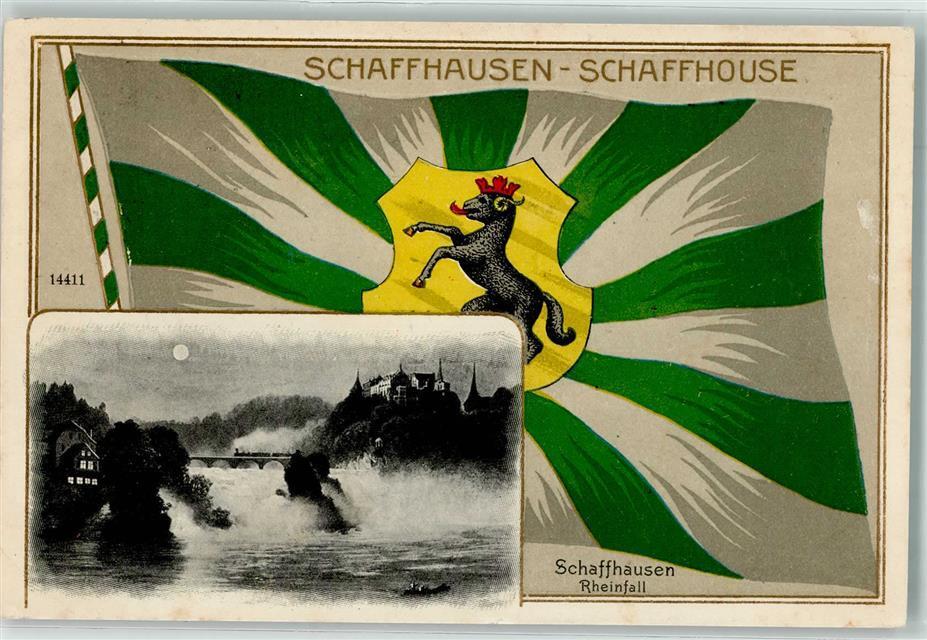Schaffhausen canton (Switzerland) (original) (raw)
On a yellow field, a leaping black ram with golden horns, hooves, penis, and crown, and a red tongue. This flag has a minor heraldic error in that it combines actual gold with yellow, but there was a conscious reason for this (see below).
T.F. Mills, 23 October 1997
The ram on the flag was originally unadorned, but Schaffhausen was one of the recipients of a "Julius Banner" in 1512. The ram was granted a golden crown, and its horns, hoofs and genitals were also rendered in gold. The ram was originally "rampant" standing in the classic one hoof position (rear left on the ground), but in the 1940s the ram was tilted forward to the "sautant" position with both rear hoofs on the ground (i.e. landing from a jump). For a while after the 13th century the city seal showed a ram jumping out of a city gate, based on the erroneous etymology that Schaffhausen meant "house of ;sheep".
Dragoon standard (1713, 140x125 cm). On black cloth a yellow medallion framed by a laurel wreath, showing a black ram with golden crown, virility and hooves. On the upper edge with golden letters Schaffhausen's motto "DEUS SPES NOSTRA EST" (God is our hope), on the lower edge the year "1713". Yellow-black-green fringes on three sides (b/w photo, source: [b7b42]).
Colour Flag
[![[Colour Flag SH]](http://www.crwflags.com/fotw/images/c/ch-sh_56.gif) ](../images/c/ch-sh%5F56.gif) image by Ole Andersen
](../images/c/ch-sh%5F56.gif) image by Ole Andersen
Simple rectangular cantonal flag, as shown in Kannik (1956)[So-called colour flag (Farbenfahne in German)].
Ole Andersen, 4 August 2002
See also: STATE COLOURS in Dictionary of Vexillology
| Flaggen, Knatterfahnen and Livery Colours | ||
|---|---|---|
[![[Knatterfahnen]](http://www.crwflags.com/fotw/images/c/ch-sh_f.gif) ](../images/c/ch-sh%5Ff.gif) ](../images/c/ch-sh%5Ff.gif) |
[![[Knatterfahnen]](http://www.crwflags.com/fotw/images/c/ch-sh_kf.gif) ](../images/c/ch-sh%5Fkf.gif) ](../images/c/ch-sh%5Fkf.gif) |
[![[livery colours]](http://www.crwflags.com/fotw/images/c/ch-sh_ff.gif) ](../images/c/ch-sh%5Fff.gif) ](../images/c/ch-sh%5Fff.gif) |
images by Pascal Gross
Flaggen are vertically hoisted from a crossbar in the manner of gonfanon, in ratio of about 2:9, with a swallowtail that indents about 2 units. The chief, or hoist (square part) usually incorporates the design from the coat of arms – not from the flag. The fly part is always divided lengthwise, usually in a bicolour, triband or tricolour pattern (except Schwyz which is monocolour, and Glarus which has four stripes of unequal width). The colours chosen for the fly end are usually the main colours of the coat of arms, but the choice is not always straight forward.
Knatterfahnen are similar to Flaggen, but hoisted from the long side and have no swallow tail. They normally show the national, cantonal or communal flag in their chiefs.
Željko Heimer, 16 July 2000
Why are the livery colours unexplainable from the coat of arms?
António Martins, 17 April 2001
The livery colours of Schaffhausen canton are not taken from the coat of arms. Originally, the pennon which preceded the banner was green. The laces of green colour (alone or accompanied by another one) attached to the majority of the official acts established between 1253 and 1321 attest it. An invoice from 1444 takes into account the purchase of green and black material. The black attested here as the second colour of the city can derive from the ram appearing on the banner. Since that date, all documents prove that green and black were the official colours until the end of the Ancien Regime. This fact confirms that blazons, banners and cantonal colours are not always identical and, for this reason, one need to follow their historical evolution.
Pascal Gross, 6 April 2001
Kannik (1956) mentions that the colours go back to round 1500 (Znamierowski, 2000, says 15th century), and notes that the livery colours are or and sable. Kannik also shows the canton flag as green over black.
Ole Andersen, 18 April 2001
See also: HANGING FLAG, VERTICALLY HOISTED FLAG,LIVERY COLOURS in Dictionary of Vexillology
Early 20th Century Flag Design

 images located by Martin Karner
images located by Martin Karner
(Postmark: 1908 | source) (source)
At the beginning of the 20th century, flamed flags were still in use, with the white cross replaced by a (baroque) shield in the centre of the flag. These decorative flags had been used until WWII and then somewhat forgotten in preference of the current cantonal flags. [Today they are being produced again, see right image]
Pascal Gross, 30 June 2002
See also:
- National flag and other cantonal flags with "Early 20th century flag design"
- Modern flamed flags
- FLAMMES in Dictionary of Vexillology
Logo

(source)
Cockade
 image located by Martin Karner
image located by Martin Karner
(source)
Cockade for the cantonal troops' headgear (regulation from 1898, size: ca. 35 mm, reverse side).
Martin Karner, 14 March 2025
See also: Cockades (Swiss Army)